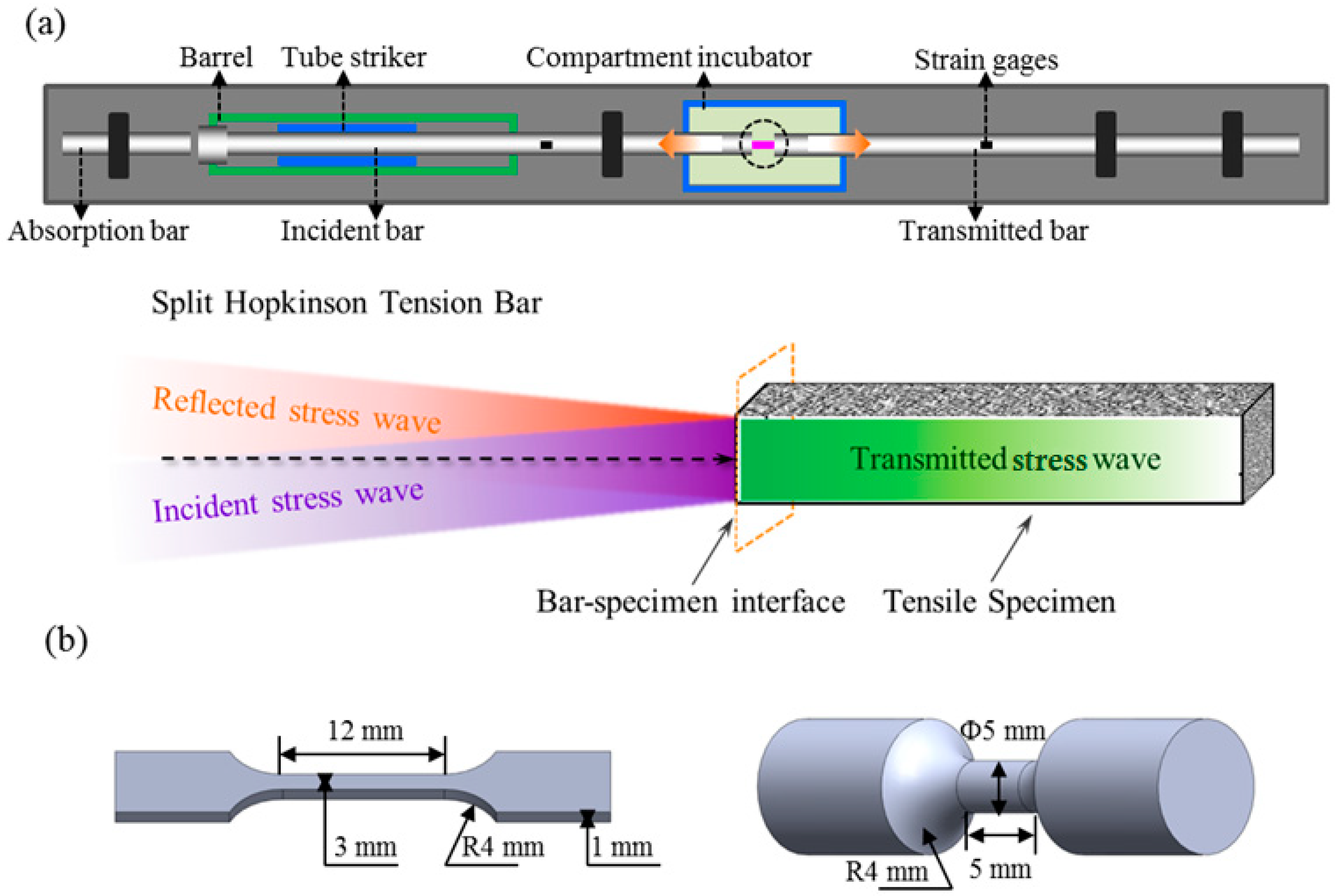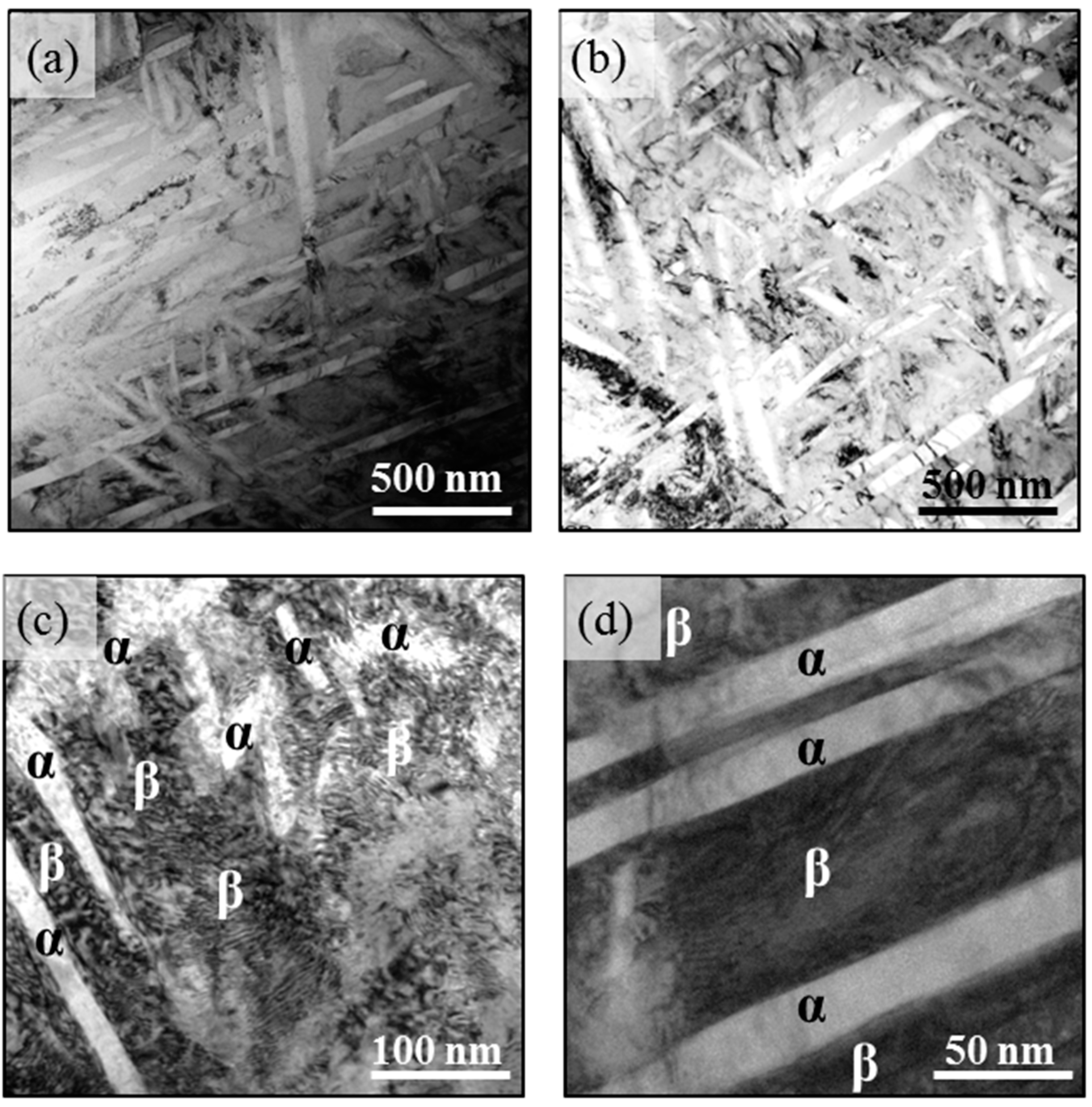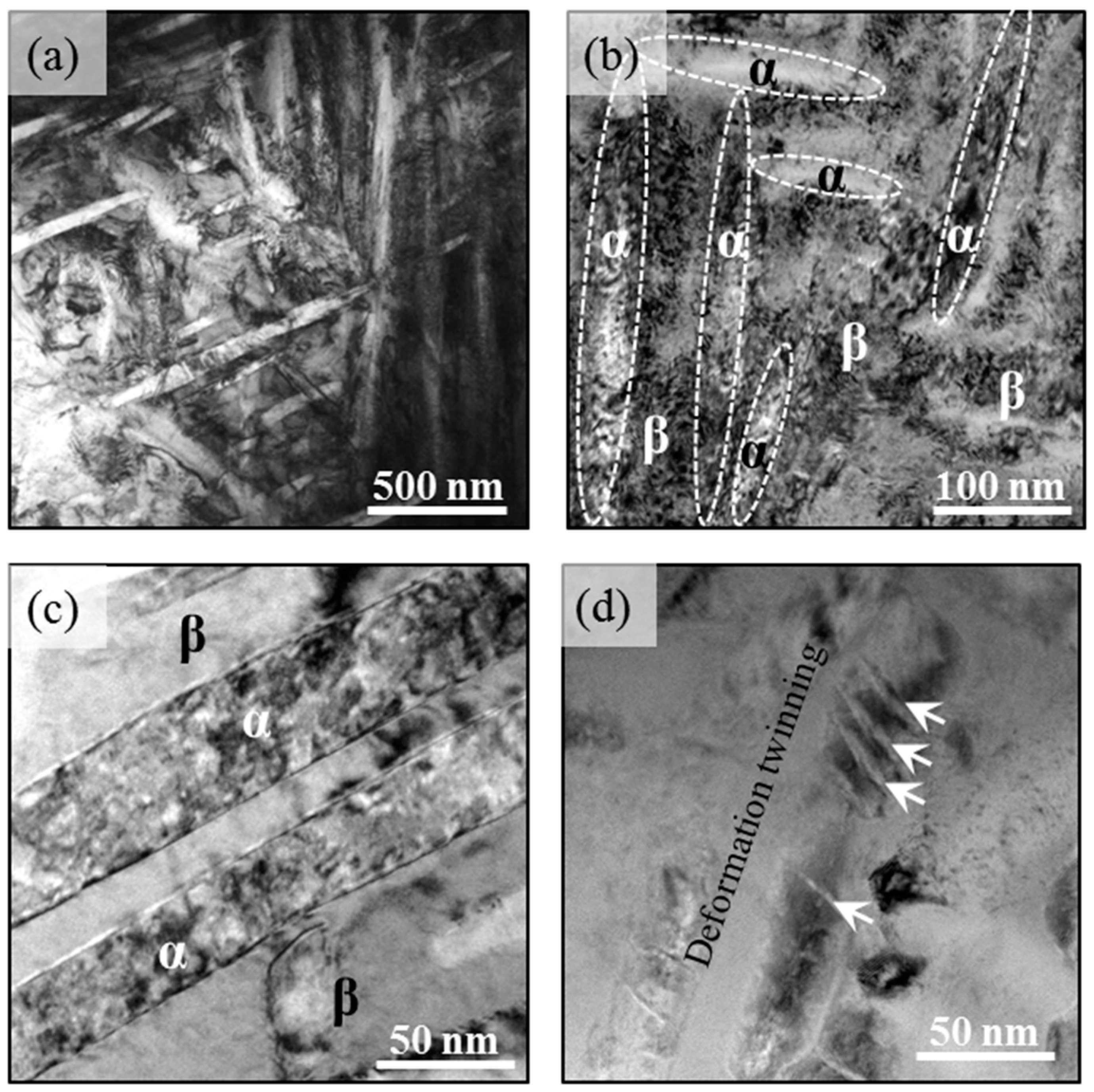Effect of α Phase on Dynamic Mechanical Properties and Failure of Ti-4Al-5Mo-5V-5Cr-1Nb Alloy after Two-Stage Aging
Abstract
:1. Introduction
2. Experimental
2.1. Sample Preparation
2.2. Characterization Methods
2.3. Mechanical Properties
3. Results and Discussion
3.1. Microstructure Evolution after Two Stage Aging
3.2. Mechanical Performance
3.3. Deformation Mechanisms
3.4. Failure Modes
4. Conclusions
Author Contributions
Funding
Institutional Review Board Statement
Informed Consent Statement
Data Availability Statement
Conflicts of Interest
References
- Wang, Y.L.; Hao, M.Y.; Li, D.; Liang, Q.L.; Wang, D.; Zheng, Y.F.; Sun, Q.Y.; Wang, Y.Z. Enhanced mechanical properties of Ti-5Al-5Mo-5V-3Cr-1Zr by bimodal lamellar precipitate microstructures via two-step aging. Mater. Sci. Eng. A 2022, 829, 142117. [Google Scholar] [CrossRef]
- Kolli, R.P.; Devaraj, A. A Review of Metastable Beta Titanium Alloys. Metals 2018, 8, 506. [Google Scholar] [CrossRef] [Green Version]
- Qin, D.Y.; Zhao, F.; Li, Y.L. The conflicts between strength and ductility of bimodal Ti-5553 alloy with fine equiaxial prior β grains. Mater. Sci. Eng. A 2022, 841, 143074. [Google Scholar] [CrossRef]
- Sauer, C.; Luetjering, G. Thermo-mechanical processing of high strength β-titanium alloys and effects on microstructure and properties. J. Mater. Process. Technol. 2001, 117, 311–327. [Google Scholar] [CrossRef]
- Meyers, M.A.; Pak, H.R. Observation of an Adiabatic Shear Band in Titanium by High-Voltage Transmission Electron Microscopy. Acta Metall. 1986, 34, 2493–2499. [Google Scholar] [CrossRef]
- Guo, S.; Meng, Q.K.; Zhao, X.Q.; Wei, Q.M.; Xu, H.B. Design and fabrication of a metastable β-type titanium alloy with ultralow elastic modulus and high strength. Sci. Rep. 2015, 5, 14688. [Google Scholar] [CrossRef] [Green Version]
- Zherebtsov, S.V.; Murzinova, M.A.; Klimova, M.V.; Salishchev, G.A.; Popov, A.A.; Semiatin, S.L. Microstructure evolution during warm working of Ti-5Al-5Mo-5V-1Cr-1Fe at 600 and 800 °C. Mater. Sci. Eng. A 2013, 563, 168–176. [Google Scholar] [CrossRef] [Green Version]
- Liu, S.F.; Li, M.Q.; Luo, J.; Yang, Z. Deformation behavior in the isothermal compression of Ti-5Al-5Mo-5V-1Cr-1Fe alloy. Mater. Sci. Eng. A 2014, 589, 15–22. [Google Scholar] [CrossRef]
- Ma, W.; Wang, F.; Chen, B.H.; Li, B.; Zhang, X.Y.; Ma, M.Z.; Liu, R.P. Thermal compression behavior and microstructural evolution of Ti-30-5-3 alloys in lower α + β region. Mater. Lett. 2021, 297, 129876. [Google Scholar] [CrossRef]
- Suri, S.; Viswanathan, G.B.; Neeraj, T.; Hou, D.H.; Mills, M.J. Room temperature deformation and mechanisms of slip transmission in oriented single-colony crystals of an α/β titanium alloy. Acta Mater. 1999, 47, 1019–1034. [Google Scholar] [CrossRef]
- Zheng, Y.; Sosa, J.S.; Williams, R.E.A.; Wang, Y.; Banerjee, R.; Fraser, H.L. The role of omega phase in non-classical homogeneous precipitation of the alpha phase in beta-titanium alloys. Scr. Mater. 2016, 111, 81–84. [Google Scholar] [CrossRef]
- Semiatin, S.L.; Bieler, T.R. The effect of alpha platelet thickness on plastic flow during hot working of Ti-6Al-4V with a transformed microstructure. Acta Mater. 2001, 49, 3565–3573. [Google Scholar] [CrossRef]
- Lu, J.; Zhao, Y.; Ge, P.; Zhang, Y.; Niu, H.; Zhang, W.; Zhang, P. Precipitation behavior and tensile properties of new high strength beta titanium alloy Ti-1300. J. Alloys Compd. 2015, 637, 1–4. [Google Scholar] [CrossRef]
- Santhosh, R.; Geetha, M.; Saxena, V.K.; Nageswararao, M. Studies on single and duplex aging of metastable beta titanium alloy Ti-15V-3Cr-3Al-3Sn. J. Alloys Compd. 2014, 605, 222–229. [Google Scholar] [CrossRef]
- Huang, J.; Wang, Z.; Xue, K. Cyclic deformation response and micromechanisms of Ti alloy Ti-5Al-5V-5Mo-3Cr-0.5Fe. Mater. Sci. Eng. A 2011, 528, 8723–8732. [Google Scholar] [CrossRef]
- Xu, Y.B.; Bai, Y.L.; Meyers, M.A. Deformation, Phase Transformation and Recrystallization in the Shear Bands Induced by High-Strain Rate Loading in Titanium and Its Alloys. J. Mater. Sci. Technol. 2006, 22, 737–746. [Google Scholar]
- Ran, C.; Chen, P.W.; Li, L.; Zhang, W.F.; Liu, Y.L.; Zhang, X. High-strain-rate plastic deformation and fracture behaviour of Ti-5Al-5Mo-5V-1Cr-1Fe titanium alloy at room temperature. Mech. Mater. 2018, 116, 3–10. [Google Scholar] [CrossRef]
- Clément, N.; Lenain, A.; Jacques, P.J. Mechanical property optimization via microstructural control of new metastable beta titanium alloys. JOM 2007, 59, 50–53. [Google Scholar] [CrossRef]
- Mishra, A.; Martin, M.; Thadhani, N.N.; Kad, B.K.; Kenik, E.A.; Meyers, M.A. High-strain-rate response of ultra-fine-grained copper. Acta Mater. 2008, 56, 2770–2783. [Google Scholar] [CrossRef]
- Meyers, M.A. Dynamic Behavior of Materials; Wiley-Interscience: New York, NY, USA, 1994; pp. 323–326. [Google Scholar]
- Zheng, Z.; Waheed, S.; Balint, D.S.; Dune, F.P. Slip transfer across phase boundaries in dual phase titanium alloys and the effect on strain rate sensitivity. Int. J. Plast. 2018, 104, 23–38. [Google Scholar] [CrossRef]
- Zheng, Z.B.; Balint, D.S.; Dunne, F.E. Investigation of slip transfer across HCP grain boundaries with application to cold dwell facet fatigue. Acta Mater. 2017, 127, 43–53. [Google Scholar] [CrossRef]
- Li, X.Y.; Wei, Y.J.; Lu, L.; Lu, K.; Gao, H.J. Dislocation nucleation governed softening and maximum strength in nano-twinned metals. Nature 2010, 464, 877–880. [Google Scholar] [CrossRef] [PubMed] [Green Version]
- Huang, C.W.; Zhao, Y.Q.; Xin, S.W.; Zhou, W.; Li, Q.; Zeng, W.D. Effect of microstructure on tensile properties of Ti-5Al-5Mo-5V-3Cr-1Zr alloy. J. Alloys Compd. 2017, 693, 582–591. [Google Scholar] [CrossRef]







| Position | Chemical Composition (wt.%) | |||||||||
|---|---|---|---|---|---|---|---|---|---|---|
| Al | Mo | V | Cr | Nb | C | N | O | H | Ti | |
| Top | 4.00 | 4.99 | 5.03 | 5.01 | 1.03 | 0.005 | 0.007 | 0.107 | 0.0006 | bal. |
| Middle | 3.98 | 5.02 | 5.01 | 5.04 | 1.05 | 0.005 | 0.004 | 0.105 | 0.0004 | bal. |
| Bottom | 4.03 | 4.97 | 5.04 | 5.02 | 1.01 | 0.005 | 0.006 | 0.107 | 0.0007 | bal. |
Publisher’s Note: MDPI stays neutral with regard to jurisdictional claims in published maps and institutional affiliations. |
© 2022 by the authors. Licensee MDPI, Basel, Switzerland. This article is an open access article distributed under the terms and conditions of the Creative Commons Attribution (CC BY) license (https://creativecommons.org/licenses/by/4.0/).
Share and Cite
Wang, T.; Liu, X.; Feng, Y.; Wang, K.; Sun, S.; Yang, D.; Sun, F. Effect of α Phase on Dynamic Mechanical Properties and Failure of Ti-4Al-5Mo-5V-5Cr-1Nb Alloy after Two-Stage Aging. Metals 2022, 12, 1721. https://doi.org/10.3390/met12101721
Wang T, Liu X, Feng Y, Wang K, Sun S, Yang D, Sun F. Effect of α Phase on Dynamic Mechanical Properties and Failure of Ti-4Al-5Mo-5V-5Cr-1Nb Alloy after Two-Stage Aging. Metals. 2022; 12(10):1721. https://doi.org/10.3390/met12101721
Chicago/Turabian StyleWang, Tao, Xianghong Liu, Yong Feng, Kaixuan Wang, Shangqing Sun, Dong Yang, and Feng Sun. 2022. "Effect of α Phase on Dynamic Mechanical Properties and Failure of Ti-4Al-5Mo-5V-5Cr-1Nb Alloy after Two-Stage Aging" Metals 12, no. 10: 1721. https://doi.org/10.3390/met12101721






